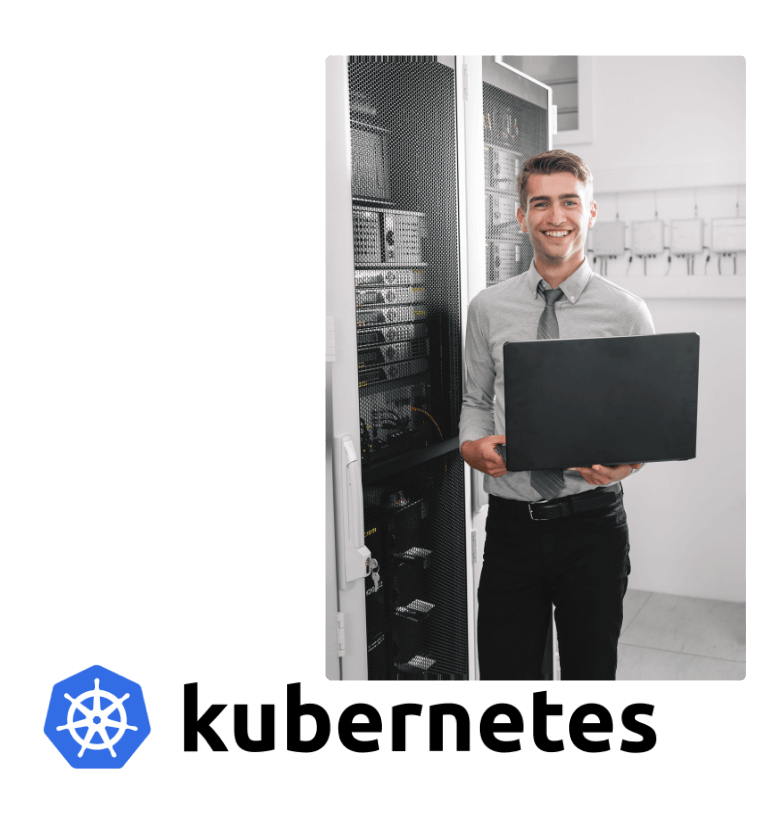Kubernetes isan open sourcecontainer orchestrator. It facilitates the management of containerized applications that are broken into dozens or even hundreds of containers. Kubernetes also makes it possible to manage the application on distributed environments no matter if we are talking about infrastructure in your corporate server room, hybrid or cloud computing.
Kubernetes makes it possible to respond to loads and failures in the service. As a result, when the load level exceeds a certain value, Kubernetes automatically starts new containers to spread the load across multiple machines. This, in turn, avoids overloading a single machine and keeps the application running.
The main task of the platforms is to help master complex environments where multiple containers on different servers are enabled. Kubernetes addresses service complexity by providing solutions that run distributed systems with the highest reliability. Controlling the course of action is possible through an API. Its common use is to participate in the implementation of microservices.
The best solutions are those that work and are tailored to your business. That’s why we make sure that our administrators undergo the necessary training and remain up-to-date with all technological innovations. You can be sure that every action is specified and any error related to the server environment is quickly resolved. In addition, through completed projects, we are familiar with the needs of e-commerce, Software House, Fin-tech and public sector companies.
At Qlos, we take a fresh approach to each project. We strive to tailor solutions perfectly for clients, their needs and capabilities. We do not follow the usual patterns. Each of our IT environments is unique and one-of-a-kind. It is worth choosing the right solutions for your business. Keep in mind that a well-designed IT infrastructure yields benefits in a short period of time.
Do you have a problem right now? All other service companies are spreading their hands? For us, nothing is impossible. We operate 24/7/365, which means you will never be left with problems alone. You can be sure that our administrators will take care of you as soon as possible. Or do you need software for a specific date? Timeliness is our specialty. We always deliver system solutions at the agreed time.


Running a distributed environment or fast response in case of failure are not the only problems we solve with Kubernetes. Kubernetes solves problems related to the development and maintenance of containerized applications, such as:
In addition, our team knows and can handle challenges that are usually unfamiliar to IT teams accustomed to developing and maintaining monolithic applications.
In addition, it solves the problem of strong infrastructure scripting by providing native tools and making procedures consistent in a way similar to how a programming framework works.
In addition, a properly configured platform provides:
At Qlos, we will design your infrastructure on which the application can be developed and maintained, whether you are a contractor or an end customer. We will take appropriate measures so that you can enjoy the end result.
There are many ways to install and configure Kubernetes, including using tools such as kubeadm, kops or kube-spray, as well as cloud platforms such as Google Kubernetes Engine (GKE) or Amazon Elastic Kubernetes Service (EKS). Depending on the installation and configuration method you choose, procedures may vary, so be sure to review the documentation and instructions specific to your platform of choice.
To automate application deployment in Kubernetes, you can use tools such as Helm, Kubernetes Operators or Jenkins X. These tools offer many features, such as application lifecycle management, automatic scaling, automatic restoration, automatic deployment and application updates, and application monitoring.
Best practices for Kubernetes include areas such as security, monitoring, scaling, deployment, configuration and management. Some of the best practices include using automation tools and infrastructure as code, following DevOps practices, using application and cluster monitoring tools, deploying applications in version-controlled versions, using horizontal and vertical scaling, and regularly updating software and security.
To use Kubernetes securely, it’s a good idea to follow a number of best practices, such as using authentication and authorization, using security containers, limiting permissions, using TLS for communication between nodes and servers, and regularly updating the software and monitoring the cluster. It is also important to follow the security rules related to password management, authentication and two-factor authentication.
Kubernetes is an open source container management system that helps automate the deployment, scaling and management of container-based applications. Kubernetes offers many features, such as load balancing, automatic restore, automatic scaling, load distribution and automatic application deployment and updates.
To run an application in Kubernetes, you must first define the application configuration in YAML or JSON files, and then upload these files to the Kubernetes cluster. The configuration should include information about the container or containers to be run, along with network, port and volume information. Then use the kubectl apply command to apply this configuration to the Kubernetes cluster and run the application.
To scale an application in Kubernetes, you can use the kubectl scale command to manually change the number of instances of the application, or define automatic scaling in YAML or JSON files such as Deployment or HorizontalPodAutoscaler. With these features, Kubernetes can automatically scale
Alternatives to Kubernetes include. Docker Swarm, Apache Mesos, Nomad and Cloud Foundry. Each of these platforms offers different features and advantages, but Kubernetes is the most popular container management system and is considered the standard.
Get in touch with us!